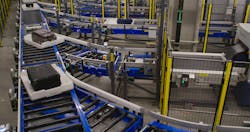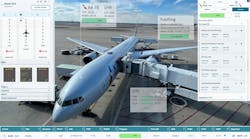The Individual Carrier System (ICS) baggage handling system is designed for shared airline use. It enables 100 percent track and trace as each bag remains in the same tote throughout the baggage handling and integrated security screening process. All bags are tracked with RFID tags on the CrisBag System, so it’s quicker to identify if a bag becomes missing along the process.
“Instead of trying to handle bags which are soft and squishy and roll and you can be quite problematic from a material handling standpoint, we put it into a container or tray and then we convey that throughout the system and it’s just a lot easier to handle from a material handling standpoint,” said David Delaney, vice president and general manager for the airport division, North America, Beumer Group. “It’s more efficient to use, it’s less material to have it run and it uses less energy. It uses less spare parts and the overall system is just a higher performance system because you can move a lot of bags a lot faster than you can on just a conveyor belt.”
Greg McCarthy, project manager for SFO, said the airport had previous success with common-use bag systems at Terminal 2 and the International Terminal so they wanted to pursue that again in the new terminal. Previously Terminal 1 had six independent airline systems with 15 screening machines. In addition, SFO wished to improve baggage tracking, increase ramp operations safety, reduce energy usage and environmental impacts.
“Beumer has been doing this for 20 years so it’s a proven system,” he said. “We’re not paying for R&D.”
The integration of an Explosives Detection System (EDS) makes CrisBag the first system to be certified by the Transportation Security Administration (TSA) for in-tote baggage security screening.
ICS systems are commonplace across the world, but this was the first in the U.S. Delaney said they had to coordinate with TSA to ensure it met their needs.
“All of their specifications and all of their standards have been written for the way that TSA is been doing things for 15 to 20 years and then we come with the new technology in a new product,” he said. “There was a lot of educating the market and us being educated by TSA and TSA understanding our product.”
The consolidation to a shared use baggage system allows redundant routes to balance the load between the Computer Tomography X-Ray’s (CTX). This reduced the number of CTX devices from 15 to seven, which are needed for baggage screening within the terminal.
Newer technology and a more efficient system also means a 70 percent reduction in energy usage by switching to an ICS baggage system.
The layout of the CrisBag ICS enabled the airport to reduce tug traffic. The inbound, transfer and outbound processes are handled in the CrisBag system and located in the baggage operational areas which are distributed throughout the terminal boarding area adjacent to the aircraft gates. Arrival baggage is taken via tugs from a flight and delivered to the inbound system infeed and the tug returns with the outbound baggage for a different flight. The totes from the make-up area are returned to the main terminal building carrying the arrival bags. This optimizes system operation and increases capacity by avoiding circulating empty totes.
The CrisBag System was chosen as part of the Harvey Milk Terminal at SFO, which replaced the old Terminal 1. The airport built the baggage handling system and leased it back to the airlines so it’s just one system.
“The nicest thing about this project was it was a design-build project where we were brought on at the same time as the building designers,” Delaney said. “It wasn’t like a situation where we were given a set of prints that we had to comply with. We were working hand-in-hand with Hensel Phelps in the design build teams from day one.”
SFO is currently the only airport in the U.S. that currently is completely certified to have bags travel in totes throughout the entire screening process, including when additional screening is needed.
“What’s quite unique about our system in San Francisco is the operators can open the bag while it’s still in the tote,” Delaney said. “In conventional systems they have to drag the bag off of a conveyor belt onto a table. You have to inspect it on the table. Then they have to manually push it back onto a conveyor belt. The TSA has had a number of workplace injuries from lifting these 60-70 pound bags.”
The system went online in April 2020, with the TSA able to test the system just before shelter in place orders took effect in the San Francisco Bay Area. The system is operational. It’s tested it signed off by TSA and airlines are using it while the second phase of the building is complete.
“Though the system came online in April 2020 with reduced bag volumes, the total benefit has yet to be realized but efficiencies are still occurring,” McCarthy said. “Traceability of each bag is a huge benefit to airline and airport operations. Reduced tug traffic for outbound/inbound bags with a head of stand road has been realized and will only grow as volume returns. Since the touch points of the system are the same, the challenges are minimal and mostly ensure the ramp operators know where the outbound and inbound bags are going.”
Delaney said they can also do virtual testing of the system. The tester gets the system to believe there’s a bag on it, so it’ll go through screening. It’ll get a screening result and will sort the virtual bag.
“Other projects that we’ve done, we’ve had to put 2,000,000 bags through the system to prove that it works,” he said. “You have to have humans loading and unloading 2,000,000 bags from that system tagging them and moving them”.
He said there’s a misconception even in the industry that these systems are far more expensive, but Beumer has been building these systems for 20 years throughout the world.
Delaney said airports looking at installing an ICS system needs to work with their consultants and let them know they’re considering this when doing master planning so it allows architects and general contractors to consider new technology in the future. You should also consider designers who are familiar with how ICS systems work as well.
“We can generally fit into similar spaces as existing in traditional systems, but you want to you know you want to think about this up front in your plans,” he said. “It’s not a lighting system or HVAC system where it’s just standard off the shelf commodity, it’s a new technology and you just sort of have to consider it fairly early on in the process. When you start your programming phase or initial planning.”
McCarthy said airports looking at an ICS system should begin with the design build core subs as early in the process as possible. Terminal 1 benefited from having Beumer in the room when the building footprint was being determined. This enabled the structure of the building to adjust to the bag system as needed and with minimal impacts. This early collaboration allowed for the use of column imbeds to support the bag system. So all attachments were integrated and visual site lines improved over suspending the system with countless treaded rods.
“Technology is great but only if it has been proven in industry to work,” he said. “R&D in live operations is not fun and should not be pursued. So when evaluating a technology to improve airport operations, need to ensure implementing it will only be a value add and not detract daily operations.”
The Pandemic Impact on Baggage Handling
There are several competing demands right now, coming out of the pandemic. Larry Studdiford, president, Studdiford Technical Solutions LLC, said a number of major airport infrastructure projects were put on hold last year that are now coming back with a sense of urgency due to the quicker-than-expected return to pre-pandemic levels. Some airports are already back to 2019 levels in terms of peak bag demands, and in some cases, already exceeding those numbers.
Those airports that did not take advantage of the downtime for necessary maintenance upgrades are finding themselves caught between the need to fix those portions of the baggage handling system that require it and the need to expand for added capacity.
Add to that the resulting change in such factors as Bags Per Passenger due not only to the leisure/business mix but also to the checked bag fee waivers by some airlines and you have an unanticipated rise in capacity demand.
“Another interesting result of the pandemic that we’re seeing is a rapid expansion of smaller markets as airlines increase their flight frequencies to more remote areas,” Studdiford said. “We are seeing several airports advancing master plans for expansion due to the need to support their growing populations due to teleworking. If you follow the housing market at all, you will see vacation homes in places like beach communities and adjacent to national parks go through the roof. The adjacent airports are finding themselves in a position of rapid expansion to support this, and in many cases the resulting BHS is going to be more sophisticated than they are used to due to evolving technology.”
The pandemic is having less impact on baggage handling system investment than many expected. The idea of sanitizing bags for COVID-19 contamination began to get traction last summer, but Studdiford said as the data continued to mature, the perceived benefit began to diminish. He said he’s not aware of a single airport in the U.S. that is investing in automated sanitization tunnels for inbound or outbound baggage, other than the ones integrated at the checkpoints for cleaning of the carry-on item bins.
He suggested what airports should think about is the process for claiming bags in the arrivals hall and the proximity of people standing around the claim carousel waiting for their bags.
“I think there is an opportunity here for expanding the level of service and improving customer satisfaction by providing more square feet per passenger, automated notifications of when one’s bag is arriving at the carousel or investigating on-demand bag retrieval,” Studdiford said. “However, these all take terminal space, which is always at a premium.”
A Big Move on Technology
Software providers are building new innovations to enhance baggage handling systems without massive construction costs.
Khaled Nabli, who heads Digital Aviation at Siemens Logistics, said the pandemic created volatility challenges in airports. The need to scale up and scale down passenger volumes and baggage handling is a major challenge as the industry continues to recover from the pandemic.
Airports are also faced with limited investment possibilities given the severe financial impact of the pandemic. Demand for an elevated passenger experience and safer facilities creates challenges that require unique solutions.
“This means large cutbacks in infrastructure projects, which drives our customers to look into alternative business models or investments and digitalization has many promising opportunities,” he said. “Many customers are looking at how they can improve and build a roadmap for the future of post-pandemic operations leveraging digitalization and automation.”
Siemens’ baggage and airport operations software Baggage 360 supports all aspects of baggage logistics and operations in airports. It assists in optimizing the baggage flow by enabling airport stakeholders to plan and allocate their fixed, mobile and human resources optimally. Thus, the software supports airports to restart operations and efficiently adapt them to the changed market conditions.
Nabli said Baggage 360 provides end-to-end transparency in the baggage handling process. It provides technical interfaces to allow all stakeholders in the baggage handling process to access information between each level. It also provides real-time operational suggestions for the stakeholders to improve the processes.
One of the challenges airports have is they own and operate large scale baggage handling systems and many stakeholders, like the airlines, the ground handlers and the passengers depend on a great performance of the baggage handling system, Nabli said. There has been a traditional conflict between stakeholders due to a lack of transparency of the data related to the baggage process. On top of that every stakeholder sets its own priority to manage baggage operations.
“There has been an ongoing debate about whose fault is it when bags arrive late to the arrival carousel; whose fault is it if the queuing time on a check-in is too long; whether the airport has sufficient capacity to meet the demand and it’s not easy to pinpoint because there are multiple stakeholders involved in each process step,” he said. “The benefit of deploying this type of technology is you provide a single point of truth for all stakeholders. You have the same view about your baggage process, baggage resources, delays and any opportunity for optimization along the process.”
The system utilizes advanced AI and machine learning algorithms to detect patterns and build models to forecast the operations up to 24 hours in advance. This benefits all stakeholders as it allows them to incorporate all available information and profit from proactive collaboration, reliable predictions, recommendations to handle their part of the process in this highly dynamic environment.
Traditional processes have a shortcoming when things don’t go as planned. Any operational disruption or even weather-related delays can’t be incorporated into planning. The new process involves a real-time feedback loop, which provides the airport with the capability to react to changes in a more agile and coordinated manner. Baggage 360 analyzes the impact of any changes in flight schedules, parking positions or resource availability and provides a proactive view to stakeholders so they can adjust operations to meet the new demands.
“Each stakeholder is informed about the anticipated changes, the predicted impact and recommended actions so they can adjust their airport operations and provide a great passenger experience,” Nabli said.
Baggage 360 requires Siemens provided training and little infrastructure investment. It’s provided via Siemens cloud services and is system independent, so it integrates with all types of baggage handling systems.
Before investing in a software solution like Baggage 360, Nabli said airport managers should consider their airport’s baggage handling success rate and how on-time performance is related to the baggage handling system. Larger hubs should examine connection times and what payoffs could be gained to lessen the time.
“If there’s a clear need or they want to improve baggage handling KPIs digital solutions could bring a large benefit,” he said.
Air Black Box recently introduced its new ThruBag system, which provides a software solution to allow efficient transfer of baggage between airlines.
Patrick Edmond, chief commercial officer of Air Black Box, said the rise in low cost carriers has created new market where passengers are opting to self-interline their flights in order to get lower costs or better schedules on flying. However, it created an environment where these passenger had to leave the terminal, collect their baggage and recheck it before entering the gate area again.
ThruBag allows them to check their bag once at the origin airport and collect it when they get to their destination.
“Even if you’re on two separate tickets, you check your bag in at the first airport, the ThruBag system takes care of it being transferred through your through airport,” he said. “You don’t even need to do anything and you pick it up at your destination airport like you would on a legacy airline.”
Edmond said the solution is very attractive to network airlines because they’re looking at ways to grow their partnerships post-COVID while still offering their basic passenger experience. It’s also attractive to low-cost carriers that are always looking for ancillary revenue.
Airports can also use the system to build connecting traffic and grow revenues as well.
“If you’re an airport and you’re not a prime hub, but you have a mix of legacy carriers and low-cost carriers coming into your airport and you’d like to find a way to increase traffic, being able to offer this kind of ThruBag product makes your airport a more attractive connecting point,” Edmond said.
ThruBag is designed to not change or impede current baggage handling processes. Once the bag is checked, the system runs it through like a traditional interline flight. It’s designed to not change or impede current baggage handling processes. Once the bag is checked, the system runs it through like a traditional interline flight.
Edmond said the airport doesn’t have to change its baggage handling system, nor its processes in any material way and airlines don’t need to sign up for any heavy-duty interline agreements.
“Anyone looking for a solution like this needs to make sure it has very minimal upfront costs,” Edmond said. “It should be as flexible as possible and it shouldn’t require any of the participating airlines to change their processes either. Ultimately, this is about creating a more efficient air transport network and making it easier to fill as many flights as possible.”




